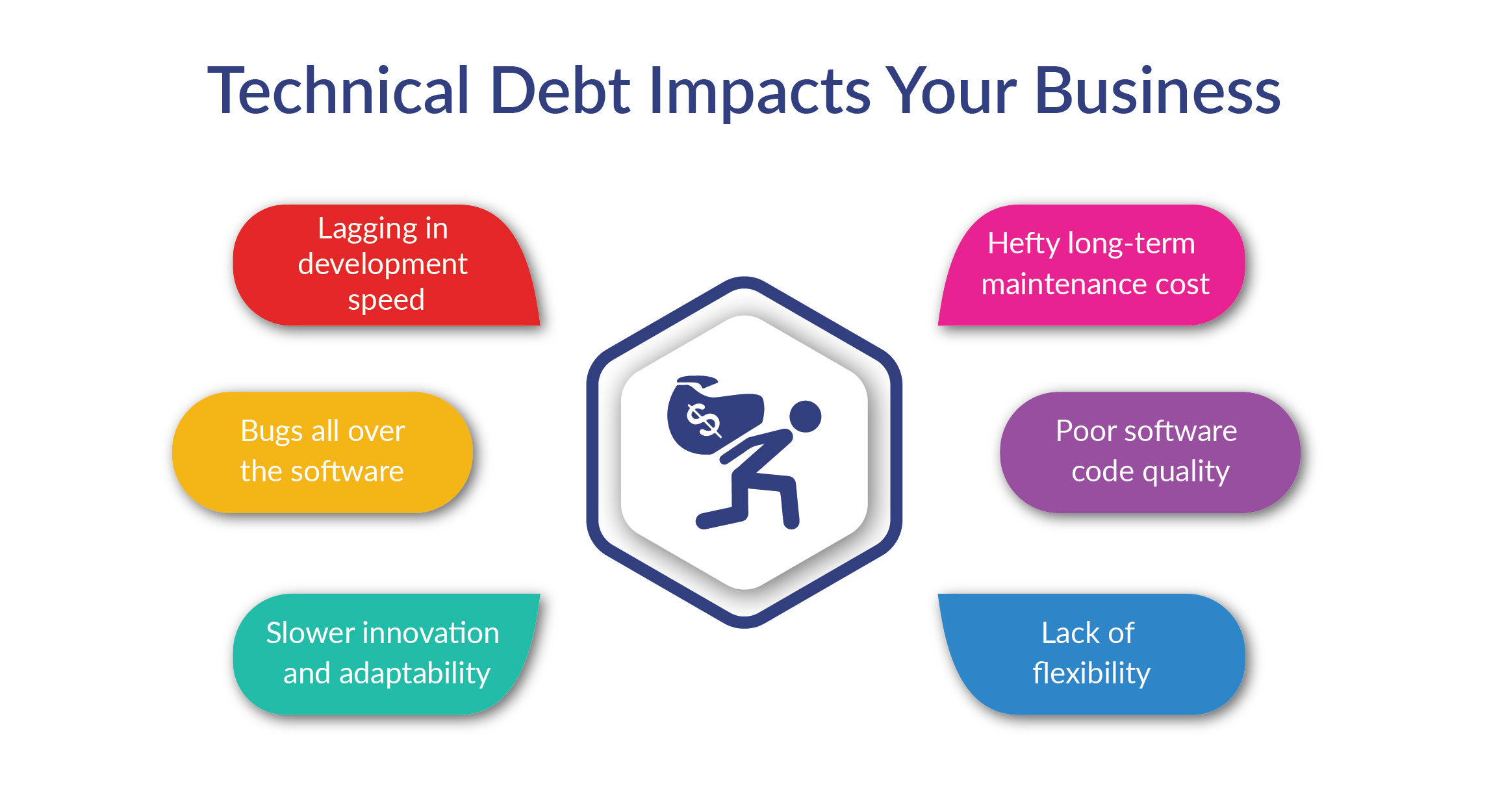Quick Summary:
Coding is a crucial factor in developing any software. Imperfection in coding or mundane code quality are the topmost reasons that can accumulate technical debt in software development. But partnering with the right development company and implementing the right software development strategies, as they say, can either entirely reduce or eliminate the chances of technical debt.
Table of Contents
What is Technical Debt in Software Development?
Technical debt, code debt, or design debt all have the same meaning. Due to the laid back practice of building quickly without ensuring quality of the code and deciding to fix bugs later, technical debt increases. In a hurry to make the software available for the target audiences, entrepreneurs, CTOs, or businesspeople, the development team usually ignores the tech issues and also due to the unclarity of requirement or specifications of the end product the developers build the software available as soon as possible.
As you landed on this blog, it might be possible that you are a victim of a technical debt, or you want to ensure that you do not want to carry this burden by ensuring quality and flawless software development.
Technical debt in software development can be more resource and time-demanding in the long run. It is quite similar to financial debt, which demands interest on the principal amount.
Below is an example showing how accumulating tech debt can make your business disappear from the market.

Source: Quora Question and Answers
This is not the only case; even big tech giants like Microsoft have fallen into the trap of tech debt. Take a look at the below screenshot.

Now that you know the various tech debt examples, let us introduce you to the causes of technical debt.
You need to understand how tech debt gets accumulated or what causes tech debt.
Four Causes of Technical Debt
Here are the four causes of tech debt to consider and avoid, ensuring a flawless software development:
1. Insufficient testing
One of the serious causes of tech debt is insufficient testing, resulting in bug-prone code. Often you or the developers neglect the software quality assurance standards, leading to wretched code and testing measures. Such practices do not offer fruitful results; instead, it only accumulates tech debt, which puts you in hassle in the long term.
2. Stakeholder pressure
Another cause of tech debt is focusing more on meeting deadlines defined by stakeholders rather than the build quality of software. In this scenario, you (as a decision maker) should ensure that your hired resource gets sufficient time and project clarity to build your software without any time pressure. Pressurizing developers to build software quickly may lead to negligence in code quality, resulting in bugs and poor performance. Besides, there can be compromises in design and proper documentation.
3. Unsupported documentation
Developers will be challenged to maintain the codebase when there is unsupported documentation, including a lack of comments and outdated or incomplete information. All these bad practices lead to the accumulation of technical debt, impacting the process of developing a software, eventually hampering its performance.
4. Inefficient collaboration
Another cause of tech debt is an ineffective collaboration between stakeholders and software developers. Without deeply detecting bugs and errors, there won’t be a clear idea about requirements when ineffective communication leads to software building.
Shoot Up Your Revenue by Reducing Technical Debt
Consider fixing bugs and errors at the time of development to eliminate the chances of technical debt in the long term. Connect with a software development company to ensure a team building flawless software for you.
How Accrued Technical Debt Impacts Your Business?
If not addressed on time, a technical debt can waste your time, efforts, money, and manpower. Don’t fall for a trap – “build now, fix later.” This may lead to several consequences:

Lagging in Development Speed
When quick fixes, shortcuts in software development, and negligence over code quality happens, technical debt accumulates. The code quality gradually deters, making it difficult to understand, extend, and maintain, resulting in lagging in the development speed. Software developers have to spend double the time to understand the complexities, which results in poor and time-consuming performance with lesser efficiency.
Hefty Long-Term Maintenance Cost
As you know, the development speed of the software starts lagging with the accumulated tech debt and paying off even becomes resource-demanding. As a result, more manpower with hefty investment is required to pay off tech debt in the long run. Besides, any modification always remains in the pipeline because of the complexity of the existing codebase. Hence, unaddressed tech debt can save you maintenance cost in no time.
Bugs All Over the Software
If you follow “build now, fix later,” you will end up compiling bugs, making them omnipresent in your software. The piled up bugs will offer instability, poor performance, glitches, and frequent software crashes, resulting in reputational damage. With all such unmanageable tech debt, you are left with no option but to discontinue your software product.
Poor Software Code Quality
Accrued technical debt means poor coding and unreliable or a code that does not make any sense. This code is also difficult to modify or test, making it useless, and forcing you to either revamp it immediately or stall the project. Also, it leads to inconsistency, is hard to read, and does not adhere to ethical coding standards. Poor code brings in a lot of discrepancies and new bugs, which makes it challenging for developers to rectify and revamp.
Slower Innovation and Adaptability
Another major hindrance brought by the tech debt is slower or no innovation in your software systems. Due to accumulated code debt, you cannot upgrade your software to current trends, requirements, or business needs. Due to sturdy architecture with poor code quality, you need to help think of innovation since bringing in new features or implementing code refactoring to utilize new frameworks will be difficult.
Lack of Flexibility
It becomes challenging to scale up with new technologies due to technical debt. According to recent reports by McKinsey, companies reserving 10-20% for technological advancement go into paying off tech debt for resolving issues and making the software function smoothly.
How to Reduce Technical Debt in Software Development With the Six Best Strategies?
Technical debt is an avoidable challenge, but only when you and your software development team are on the same page. When both you and your development team stand on each other’s expectations, we bet you won’t face any technical debt during or post developing your software.
Here are the six strategies to mitigate technical debt and build a desired software that solves your audience’s problem and generates revenue for you.
1. Implement Effective Testing
🟠 Why is effective testing required?
One of the reasons that cause technical debt is ineffective testing during software development; this can pile up bugs and errors, leading to glitches in software, and poor performance, resulting in bad user experience and a gradually reduced user base.
🟠 How to overcome the testing challenge and reduce tech debt?
Follow agile methodologies and practice all types of functional testing. Implement automated testing practices such as unit testing, integration testing, and regression testing to eliminate regression issues, resulting in a stable and reliable code base. If possible, set up a continuous integration and deployment pipeline to catch and fix issues early. By ensuring comprehensive test coverage to minimize the risk of introducing new bugs will save you from accumulated tech debt and long-term hassle. You can hire software developers and QA professionals to test your software rigorously.
2. Review Codes Frequently
Reviewing code is one of the best tech debt practices in software development. According to one of the online reports, upon implementing a code review strategy, there was only a 2% detection of minor errors post-reviewing by peers.
3. Implement Pair/Mob Programming
Another strategy to reduce technical debt is performing pair or mob programming, an alternative to coding review. You (as a decision maker for your software) can tell us to implement either pair programming or code review.
We must ensure you with both the strategies (we, as a software development company) follow. So, coming back to our topic on pair programming, this tech debt reduction strategy involves two or more software engineers jointly delivering several benefits, such as:
- Real-time feedback on your software
- Prevents you from digging into the rabbit hole and focuses on test-driven development.
- Exchanging a wealth of information on detecting bugs and building flawless software, strictly.
4. Constant Code Refactoring
🟠 Challenge:
The software is built and damaged due to code. An understandable, organized, and clean code boosts software performance, makes it flawless, and less maintenance in the long term. At the same time, if the code is messy, unorganized, and unclear, it accumulates code debt, resulting in heavy work in the development and more resources, and that too, without any surety of enhanced performance.
🟠 Solution:
Code refactoring is a robust solution to overcome messy code challenges and helps reduce code debt in the long term. It transforms legacy code and ensures the smooth functioning of your software by increasing the readability, maintainability, and performance of the written code. Majority of the software development companies and considers code refactoring as a core part of the development process.
5. Leverage Agile Software Development Practices
Technical debt piles up and brings in a lot of hassles for business. Now that you don’t have time to overcome the challenges, it’s better to partner with a reputed software development company like Bacancy follows agile methodology to leverage iterative development and continuous innovation.
This methodology ensures consistent quality development in small phases. Besides, whatever tasks that can accumulate technical debt are all stacked up in the product backlog so that they can be easily tracked and resolved on time.
6. Effectively Rule Out the Root Cause
Apart from the development part, several other issues are equally responsible for software development’s technical debt. And not addressing these issues can welcome hassle and pressure.
These are:
- Do not pressure your software development team to speed up the process, as they might miss out on any bugs, which can cause technical debt.
- Always partner with a software development company that ensures rigorous testing codes before deployment.
- Never try to bundle up tasks for developers as they can’t focus on prioritized tasks.
- Intentional tech debt happens when software developers primarily focus on developing the software and fixing the issue.
- Unintentional tech debt: when an issue is developing, but the software team isn’t unaware, it is called unintentional tech debt.
- Make sure to rectify existing bugs and let no new bugs pile up in your software.
- Maintain code quality and ensure it always remains high.
- Ensure you always have a short cycle time, meaning the time gap between the first commit and deployment.
- Make sure you have a low code churn rate.
- Make sure your code executes during the testing suite.
Conclusion
Technical debt in software development is avoidable only if you partner with a proficient software development company. Also, if you are facing tech issues, connect with the company before it gets too late because neglecting those issues accumulates tech debt, for which repayment will be costlier than you can think.
Hire software developer from a well-reputed company to implement the strategies discussed in the blog and get flawless software for your target audience. Because not only money but technical debt also damage reputation.
Frequently Asked Questions (FAQs)
There are two types of technical debt, which are as follows:
Technical debt is neither good nor bad; it’s simply a debt that gets accumulated if not addressed on time. And accumulated tech debt can impact your software development, risking your reputation. Thus, you should never accumulate tech debt and fix it as soon as you figure it out.
There are several ways to measure code debt:
Technical debt is also known as short-term debt that happens within the project. In rare cases, this debt is accumulated intentionally, but fixing it before it creates hassles is advisable. On the other hand, maintenance debt is an out-of-control debt that even the development team couldn’t control.
Certain strategies need to be implemented to mitigate technical debt. These strategies are a sure-shot solution to reduce tech debt in the short and long term.
Your Success Is Guaranteed !
We accelerate the release of digital product and guaranteed their success
We Use Slack, Jira & GitHub for Accurate Deployment and Effective Communication.





